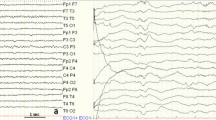Children aged 5–7 years with early childhood autism were found to have more marked right-sided predominance of alpha-rhythm spectral power both in baseline conditions and on cognitive loading (counting), along with a decreased level of alpha rhythm power than normal children. The spectral power of the fast rhythms increased from baseline on cognitive loading in healthy children. In early childhood autism, the spectral power of the gamma rhythm in baseline conditions was greater than that in healthy children. On cognitive loading, the spectral power of the fast rhythms changed to a lesser extent than in healthy children. D creased alpha rhythm power in children with autism may be a predictor for the transition from autism to schizophrenia (with both positive and negative symptomatology). The increased spectral power of the fast rhythms in baseline conditions observed here in children with early childhood autism is characteristic of schizophrenia with positive symptomatology, while the decreased reactivity of fast rhythms in response to cognitive loading seen here in patients has been described for schizophrenia with negative symptomatology.
Similar content being viewed by others
References
V. M. Bashina, Autism in Childhood [in Russian], Meditsina, Moscow (1999).
S. V. Borisov, A. Ya. Kaplan, N. L. Gorbachevskaya, and I. A. Kozlov, “Analysis of EEG structural synchronicity in adolescents with schizophrenia spectrum disorders,” Fiziol. Cheloveka, 31, No. 3, 1–8 (2005).
Zh. V. Golikova, “Development of examination stress in people with different levels of cortical activity,” Zh. Vyssh. Nerv. Deyat., 53, No. 6, 697–704 (2003).
N. L. Gorbachevskaya, Characteristics of EEG Formation in Children in Health and with Different Types of Common (pervasive) Developmental Disorders [in Russian], Moscow State University, Moscow (2000).
A. Ya. Kaplan, S. V. Borisov, and V. A. Zheligovskii, “Classification of the EEG in adolescents and segmental characteristics in health and schizophrenia spectrum disorders,” Zh. Vyssh. Nerv. Deyat., 55, No. 4, 478–486 (2005).
A. P. Kulaichev, Computerized Electrophysiology, Moscow State University Press, Moscow (2002).
P. V. Simonov, Lectures on the Operation of the Brain [in Russian], Nauka, Moscow (2001).
V. B. Strelets, “Mapping of brain biopotentials in emotional and cognitive pathology,” Zh. Vyssh. Nerv. Deyat., 47, No. 2, 226–241 (1997).
V. B. Strelets, Zh. V. Garakh,V. Yu. Novototskii-Vlasov, and R. A. Magomedov, “Relationship between power and synchronization of EEG rhythms in health and cognitive pathology,” Zh. Vyssh. Nerv. Deyat., 55, No. 4, 496–504 (2005).
T. Lepisto, T. Kujala, R. Vanhala, P. Alku, M. Huotilainen, and R. Näätänen, “The discrimination of and orienting to speech and nonspeech sound in children with autism,” Brain Res., 20, No. 1–2, 147–157 (2005).
J. Martineau, S. Cochin, R. Magne, and C. Barthelemy, “Impaired cortical activation in autistic children: Is the mirror neurons system involved?” Int. J. Psychophysiol., 68, 35–40 (2008).
E. V. Orekhova, T. A. Stroganova, A. O. Prokofyev, G. Nygren, C. Gillberg, and M. Elam, “Sensory gating in young children with autism: Relation to age, IQ and EEG gamma oscillations,” Neurosci. Lett., 434, 218–223 (2008).
G. Rippon, J. Brock, C. Brawn, and J. Boucher, “Disordered connectivity in the autistic brain: Challenges for the ‘new psychology,’” Int. J. Psychophysiol., 63, 164–172 (2007).
S. Seri, F. Pisani, J. N. Thai, and A. Cerquiglini, “Pre-attentive auditory sensory processing in autistic spectrum disorder. Are electromagnetic measurements telling us a coherent story?” Int. J. Psychophysiol., 63, 159–163 (2007).
T. Stroganova, E. Orekhova, M. Tcetlin, N. Posikera, G. Nygren, C. Gillberg, and M. Elam, “EEG evidences of aberrant brain functioning in young children with autism,” Int. J. Psychophysiol., 69, 203–204 (2008).
S. Sutton, C. Burnette, P. Mundy, J. Meyer, A. Vaughan, C. Sanders, and M. Yale, “Resting cortical brain activity and social behavior in higher functioning children with autism,” J. Child. Psychological. Psychiatry, 46, No. 2, 211–222 (2005).
G. Tononi and G. M. Edelman, “Schizophrenia and the mechanisms of conscious integration,” Brain Res. Rev., 31, 391–400 (2000).
Author information
Authors and Affiliations
Corresponding author
Additional information
Translated from Zhurnal Vysshei Nervnoi Deyatel’nosti imeni I. P. Pavlova, Vol. 61, No. 5, pp. 545–552, September–October, 2011.
Rights and permissions
About this article
Cite this article
Lushchekina, E.A., Podreznaya, E.D., Lushchekin, V.S. et al. Characteristics of the Spectral Power of EEG Rhythms in Children with Early Childhood Autism and Their Association with the Development of Different Symptoms of Schizophrenia. Neurosci Behav Physi 43, 40–45 (2013). https://doi.org/10.1007/s11055-012-9688-6
Received:
Accepted:
Published:
Issue Date:
DOI: https://doi.org/10.1007/s11055-012-9688-6




